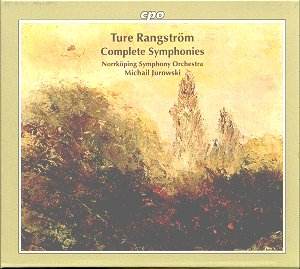Türe RANGSTRÖM (1884-1947)
Symphonies - No. 1 in C sharp minor, 'August Strindberg in memoriam';
No. 2 in D minor, 'Mitt land'; No. 3 in D flat, 'Song under the stars'; No.
4 in E flat, 'Invocatio'. Dithyramb. Spring Hymn. Intermezzo
drammatico.
 Norköping Symphony
Orchestra/Michail Jurowski.
Norköping Symphony
Orchestra/Michail Jurowski.
 CPO 999 748-2
[DDD]
[170'34]
CPO 999 748-2
[DDD]
[170'34]
Crotchet £15.99
Amazon
UK £15.99
Amazon
USA $26.57

Rangström during his day was considered to belong to the young generation
of Swedish composers of around 1910 who tried to introduce modernism into
their music, and something of this spirit of discovery lies within these
pieces. His music comes as something of a revelation: powerful, sweeping
and ecstatic are all words that could be used to describe it. Sibelius considered
Rangström 'head and shoulders above any other Swedish composer' and,
on the evidence of this CPO set, one can see why.
All of the three discs of this set have been available singly. The advocacy
of the Norköping Symphony Orchestra under Jurowski is no mean bonus.
They play with tremendous conviction.
CPO chose to preface the First Symphony with Dithyramb of 1909, a
hyper-romantic 'work of protest' which is bold, daring and challenging in
its gestures. Rangström paints his canvas with long brush strokes and
an unerring sense of confidence. The First Symphony of five years later continues
in the same vein. It is full of big contrasts, from late-Romantic splurge
to the most transparent delicacy, taking in a manic scherzo (subtitled
Trollruna) on the way. The much later Spring Hymn (1942) rounds
off the first disc. Also dedicated to Strindberg, it comes as peaceful balm
after the heroic last movement of the symphony.
The patriotic Second Symphony opens very much like a Scandinavian Vaughan
Williams. The Norköping orchestra captures the drama of the first movement
well, and throughout one is astounded at the many felicitous touches of scoring.
The coupling for this disc is the Intermezzo drammatico, and Orientally
influenced piece with a Notturno movement of magically veiled half-lights.
Symphonies Nos. 3 and 4 fit well onto the final disc. The Fourth (whose organ
part, played here by Mark Fahlsjö, adds a real sense of grandeur) is
a most impressive piece. The shadowy, macabre slow waltz of the
Intermezzo (marked sotto voce) is just one example of
Rangström's fertile invention. The slow movement is touching without
ever being cloying.
I have deliberately given the Third Symphony the last word in this review.
It is the only of Rangström's symphonies in one movement, and this seems
to free his imagination to heights only hinted at in the other pieces in
this set. The atmosphere is fantastical and expressionistic, both in harmonic
direction and in instrumentation. At times explosive, sometimes just plain
manic, always striving towards a Wagnerian scale of intent, its content belies
its 22-minute duration and leaves the most powerful of impressions. A stunning
piece.
Throughout the recording is crystal clear. The playing is exemplary. For
anyone remotely inquisitive about this truly individual Scandinavian symphonist,
this set is an essential purchase.
Reviewer
Colin Clarke
Performance

Recording

and Peter Grahame Woolf adds
Ture RANGSTRÖM (1884-1947) was largely self-taught and was thought
alarmingly modern in conservative Sweden when his youthful Dithyramb,
'a work of protest' which reacted against the prevailing 'idylls and
sentimentality of Swedish tones', was premiered in 1910. He was a devotee
of Strindberg (to whom he played it) and became active a perceptive and outspoken
music critic, defending the new. It is an arresting, full-blooded piece which
encourages further exploration. The 1st Symphony, to the memory of Strindberg,
was given in 1915 and taken up by Stenhammar. Beginning with an allegro
enthusiastico it was strikingly original for its time, with a funeral
hymn second, a whirling scherzo and a war march finale. The first of these
three CDs ends with a return to his idol Strindberg, the 1942 Spring Hymn
a seascape composed to commemorate his death 30 years before.
Rangstrom was a 'literary composer', stimulated often by poetry. The second
symphony (1919) My country in 3 movements is expansive with singing
melodic lines, 'tension and gentle forest mysticism'. Intermezzo drammatico
- from an oriental fairy play is 'a Swedish Scheherezade in
miniature' five picture postcards movements conceived s illustrations to
an imaginary play.
The third CD has Symphonies No. 3 (1929) Song under the stars 'strangely
dreamy', in Db major (!) and No. 4 (1936) Invocatio - 5 symphonic
improvisations for orchestra and organ. The first is a single movement,
suggesting a night-time sea voyage, its main motif based on one of Rangstrom's
songs Prayer to the night. The last work in this boxed set only acquired
the title symphony at a performance in 1943 - (there is a question whether
to drop the 4th of its five movements, all of which are given here). It was
built gradually from the initial source of a passacaglia & toccata for
organ, and is a substantial addition to the repertoire of orchestral music
featuring the organ.
This is not earth-shaking music, but it is more original than obviously
derivative, and is well worth exploring for those interested in the vast
range of Scandinavian music which rarely gets a hearing in UK. The performances
and recording seem excellently prepared and these 1995 CDs, now available
at a reduced price, can be recommended.
Peter Grahame Woolf

